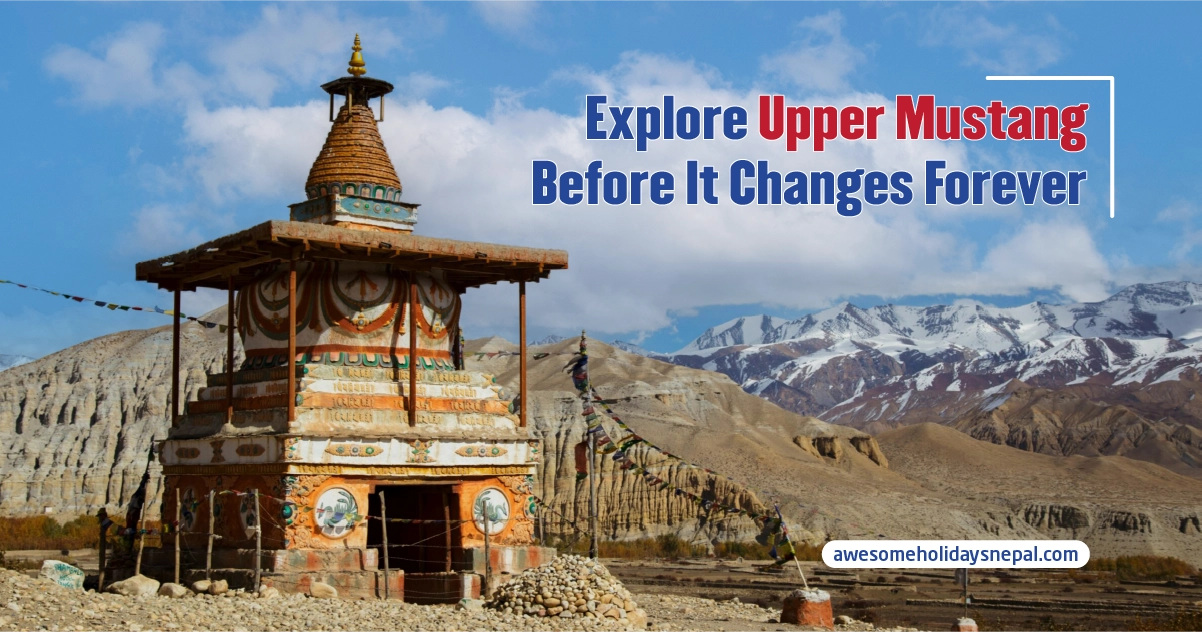Lumbini Garden: A Complete Tour Guide to The Birthplace of Buddha

Lumbini Garden is one of the most sacred pilgrimage sites in the world, representing outstanding universal value in terms of religion and culture. It is the birthplace of Buddha, lying in the Rupandehi district of Nepal.
The sacred place was listed as a UNESCO World Heritage Site in 1997 and is a symbol of peace and enlightenment. Every year, thousands of devotees and tourists visit Lumbini to experience its spiritual ambiance, explore its historical significance, and witness the grandeur of its architectural developments.
Rediscovery of Lumbini Garden in the 19th Century
In December 1896, a team of archaeologists led by the British archaeologist Alois Anton Fuhrer and General Khadga Shamsher rediscovered Lumbini. The discovery of the Ashoka Pillar erected by Emperor Ashoka in 249 BCE confirmed Lumbini as the birthplace of the Buddha, which was just a tale in the writings of Chinese monk Faxian in the 5th century and Chinese monk Hsüen Tsang in the 7th century.
Lumbini: A UNESCO World Heritage Site
After the discovery of the pillar and the garden in 1896, further excavations and research were carried out, revealing ancient ruins and structures, including the remnants of a monastic complex that suggests the area was once a thriving religious center. Excavations have revealed ancient structures, monastic ruins, and relics dating back to the Maurya periods, further solidifying its historical and religious significance.
In 1967, U Thant, Secretary-General of the United Nations, visited Lumbini and proposed to develop Lumbini as a center of pilgrimage. Then the United Nations created the International Lumbini Development Committee with members from 15 countries. Famous Japanese architect Kenzo Tange made a master plan that was approved in 1978.
In 1997, Lumbini was listed as a UNESCO World Heritage Site in recognition of its importance in the history of Buddhism and its spiritual and cultural significance as the birthplace of the Buddha. The UNESCO listing helps preserve and promote the site for future generations.
The Life of Buddha
As per the Buddhist literature, Queen Maya dreamed of a white elephant entering her womb, signifying a symbol of divine conception, before giving birth to Siddhartha in the Lumbini garden. Queen Maya, the wife of King Suddhodana of the Shakya clan, was heading to her father’s palace at Koliya Kingdom. On her way, she bathed in the pond near the garden of Lumbini and rested under a Sal tree when her labor started. She held the branch of the tree and gave birth to a child. Her helpers put a stone on where the child was born to mark the place of birth.
Later, when the Mauryan Emperor Ashoka visited Lumbini, he erected a pillar at the exact location where Siddhartha Gautam was born. The pillar with its inscriptions written in Brahmi inscription helped to identify and authenticate Lumbini as the Buddha’s birthplace, serving as one of the most significant archaeological findings in the region.
Lumbini has been a place of pilgrimage for Buddhists for more than two millennia. After the Buddha’s death, his followers visited the site to honor his birth. Ancient texts and records from the time of Emperor Ashoka and earlier show that Lumbini was known as a sacred destination for Buddhist pilgrims. But over time, this place was completely forgotten until the 19th century, when the Ashok pillar was rediscovered.
Lumbini Master Plan
The Lumbini Development Master Plan, designed by the renowned Japanese architect Kenzo Tange in 1978, aims to preserve and promote the spiritual heritage of Lumbini. The plan covers a project area of 1 x 3 miles with a circular levee and central link. It is divided into three major zones:
- Sacred Lumbini Garden: The heart of Lumbini, where the Mayadevi Temple and Ashoka Pillar are located. The area is designed to maintain tranquility and spiritual purity.
- Monastic Zone: This zone is divided into the east zone and the west zone. This zone accommodates monasteries and meditation centers, including approximately 49 stupas and monasteries. The East monastic zone is for Theravada Buddhist monasteries and the West monastic zone is for Mahayana and Vajrayana Buddhist monasteries.
- New Lumbini Village: designed to accommodate tourists and researchers, featuring the World Peace Pagoda, hotels, a museum, a research center, and other facilities.
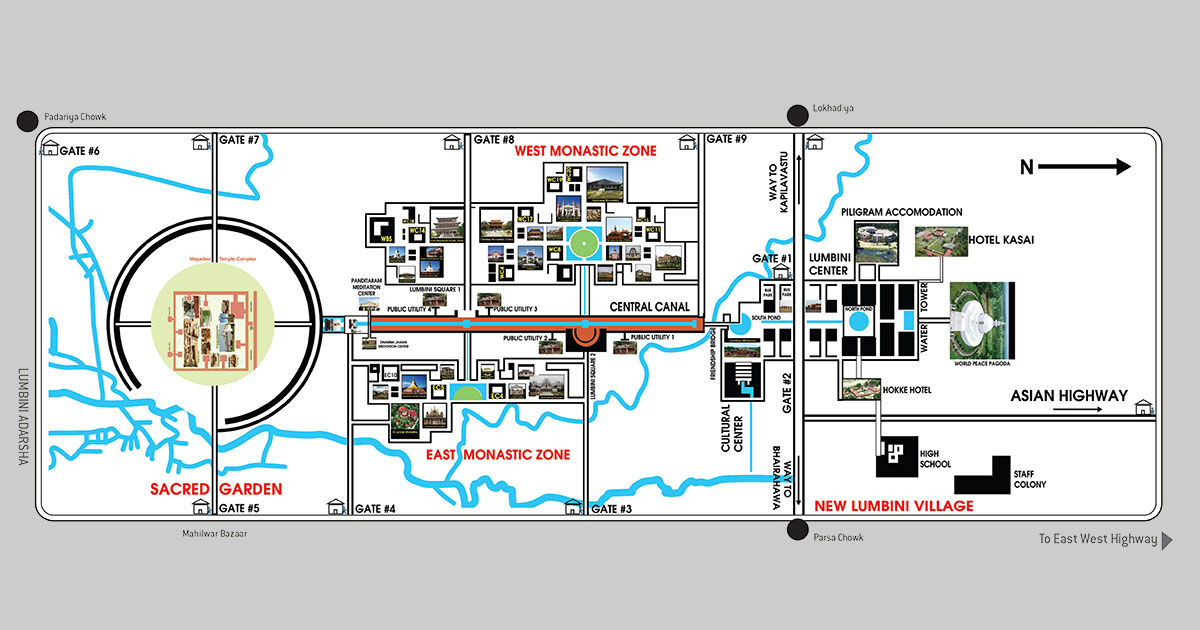
Major Attractions in Lumbini
Mayadevi Temple
The most sacred site in Lumbini, this temple houses the exact spot where Queen Mayadevi gave birth to Siddhartha Gautam within the Lumbini Garden. The temple’s inner sanctum features the Nativity Sculpture, the marker stone, and ancient ruins from various historical periods. The bricks found inside the temple date back to the third century BCE, constructed by Emperor Ashoka.
Note: It is strictly forbidden to take photographs inside the Mayadevi temple.
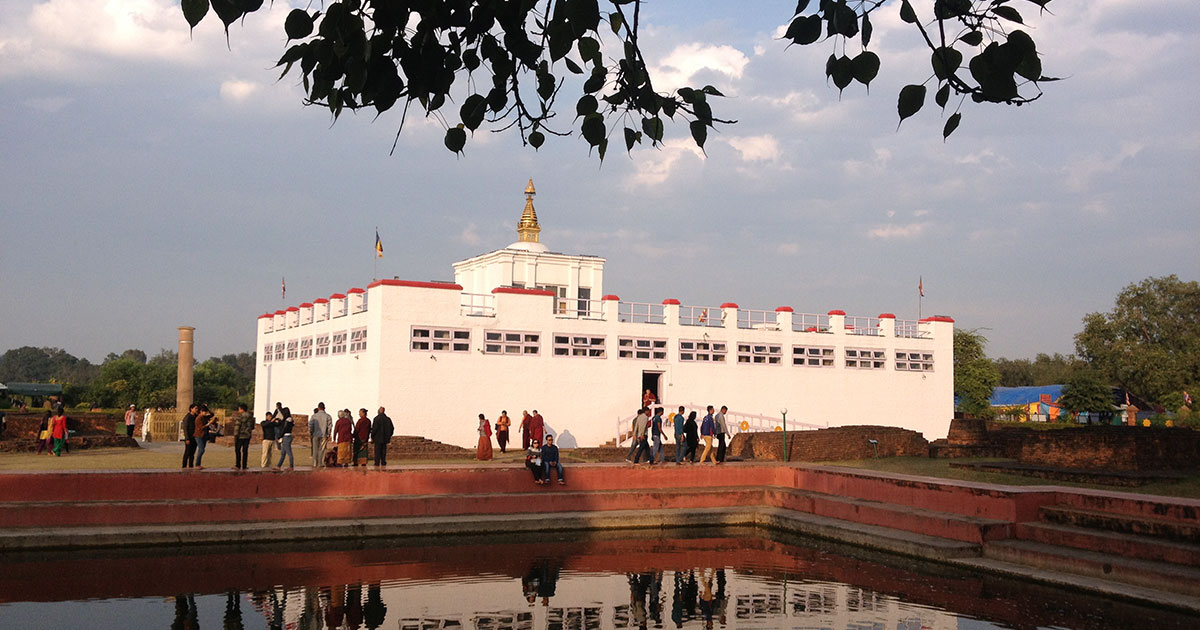
The Nativity Sculpture
This 4th-century statue describes how Mayadevi gave birth to Gautam Buddha. This also lies inside the Mayadevi temple. Maya Devi, holding a branch of a tree with her right hand, seeks support next to her sister Gautami Prajapati. The newly born boy is standing on a lotus pedestal, with two celestial figures receiving him.
The Marker Stone
The rock is located inside the Mayadevi temple. This stone marks the exact point where Gautam Buddha was born.
Ashoka Pillar
Erected by Emperor Ashoka in 249 BCE, this sandstone pillar bears inscriptions that authenticate Lumbini as the birthplace of Lord Buddha. The Ashoka pillar has its Brahmi inscriptions written in the Pali language that took years to be translated. This ancient inscription helped to identify Lumbini as the exact birthplace of Buddha.
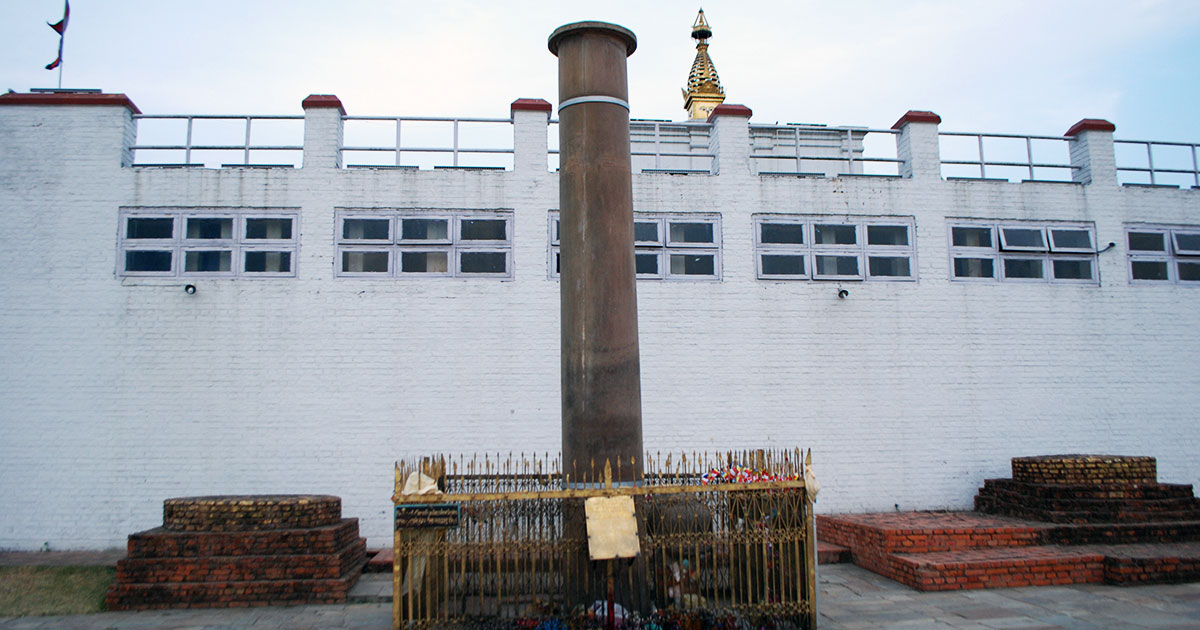
Sacred Lumbini Garden and the Holy Puskarini Pond
The Puskarini pond on the southern side is believed to be the place where Queen Mayadevi bathed before giving birth and where the infant Buddha received his first purification.
World Peace Pagoda
The Nipponzan Peace Pagoda was built by the Japanese Buddhist community to symbolize global peace and harmony.
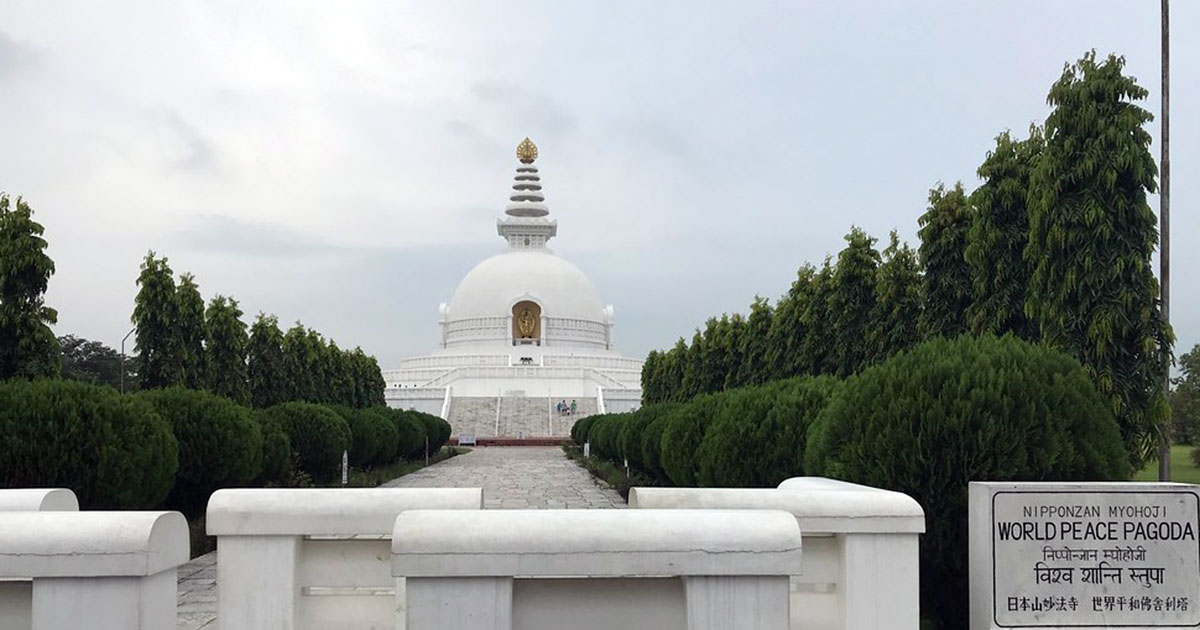
Eternal Peace Flame:
This continuously burning flame ignited in November 1986 symbolizes eternal world peace, reminding visitors of Buddha’s teachings. It was ignited to commemorate 1986 as the International Year of Peace. It is located at the southern end of the canal. The igniting flame was brought from the USA to promote global peace and harmony.
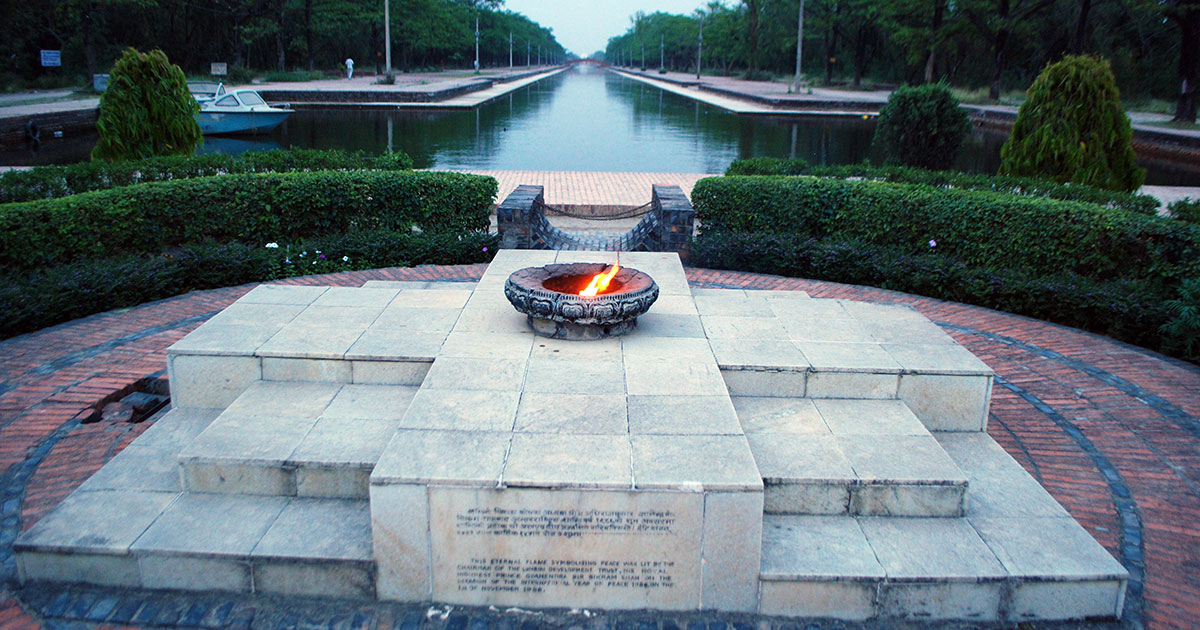
Standing Baby Buddha Statue
This shiny, happy brass statue was a gift from Thailand to commemorate Siddhartha’s early years spent in Lumbini.
The Central Canal
The 1.4 km Central Canal divides the area into left and right zones. One can pay and enjoy boating in this canal. There is a small covered motorboat that will take visitors along the canal’s length for a small fee. One end is the Eternal Peace Flame and the other is the World Peace Pagoda.
Lumbini Museum
This museum consists of ancient artifacts, Buddhist manuscripts, and historical records that depict Lumbini’s past.
Lumbini International Research Institute (LIRI)
The Lumbini International Research Institute (LIRI) is a hub for scholars and researchers studying Buddhism and its global impact.
Crane Sanctuary
Located near Lumbini, this wetland area is home to various rare species of birds, including the endangered Sarus Crane.
Lumbini Garden in Modern Days
The birthplace of Buddha stands as a significant pilgrimage site for Buddhists worldwide. The Lumbini Development Trust has played a crucial role in preserving and developing the area. At its heart lie the Lumbini Garden and the Maya Devi Temple, marking the exact spot where Siddhartha Gautama, the Buddha, is believed to have been born. Additionally, the Lumbini Museum showcases artwork reflecting the region’s rich history. The site also features numerous monuments, temples, stupas, and monasteries built by Buddhist countries such as the Maldives, Myanmar, Japan, and China, each representing different architectural styles and traditions.
Beyond Lumbini, which is a UNESCO World Heritage site, the Greater Lumbini Area (GLA) encompasses other historically significant Buddhist locations such as Tilaurakot, Kudan, Gotihawa, Niglihawa, Araurakot, Sagarhawa, Sisaniya, Devadaha, and Ramagrama. These sites provide deeper insights into the early life of the Buddha and the spread of Buddhism. Lumbini is also home to a variety of international Buddhist monasteries built by countries such as Thailand, Japan, China, and Sri Lanka. These monasteries symbolize the global influence of Buddhism and reflect the diverse ways in which Buddhist traditions have been practiced and adapted across cultures.
Lumbini’s Role in Promoting Buddhism:
Lumbini is one of the four major pilgrimage sites in Buddhism, along with Bodh Gaya (where enlightenment), Sarnath (first sermon), and Kushinagar (Parinirvana). Pilgrims travel to Lumbini to honor the birth of the Buddha and to reflect on his life and teachings. The site is a place of meditation, study, and spiritual renewal for people from all walks of life and various countries.
Visitor Guidelines
- Maintain silence in sacred areas.
- Dress modestly while visiting temples and monasteries.
- Respect local customs and traditions.
- Avoid littering to preserve the sanctity of the place.
- Do not take photographs inside the Mayadevi temple
- Do not take photographs or make videos of the saints and monks without their consent.
Experience the Peace of Lumbini
Lumbini is more than just a historical site—it is a place of spiritual enlightenment, peace, and cultural richness. Whether you seek religious inspiration, historical knowledge, or simply a tranquil retreat, Lumbini offers an unforgettable experience.
For more information, visit the official Lumbini Development Trust website or local tourism offices. So, hurry up and plan your trip to Lumbini including these highlights to enjoy one of the best place to visit in the western Nepal.
Remember Awesome Holidays Nepal to cater your memories and cherish for a lifetime.
FAQs
Expand AllIn which country was Buddha born?
Buddha was born in Lumbini, which is located in present-day Nepal.
How far is Lumbini from Kathmandu, and how can one reach there?
Lumbini is approximately 280 kilometers from Kathmandu, and it can be reached by bus, private car, or domestic flight to Bhairahawa followed by a short drive.
How many years ago was Buddha born?
Buddha was born around 2,600 years ago, in 623 BCE.
What are the key attractions of Lumbini?
Key attractions of Lumbini include the Mayadevi Temple, Ashoka Pillar, sacred garden, monasteries, and the Lumbini Museum.
What historical evidence supports Lumbini as Buddha’s birthplace?
The Ashoka Pillar, erected by Emperor Ashoka in 249 BCE, and archaeological excavations confirming ancient structures support Lumbini as Buddha’s birthplace.
What is Lumbini famous for?
Lumbini is famous as the birthplace of Siddhartha Gautama, who later became Buddha, the founder of Buddhism.
What is the area of Lumbini Province?
Lumbini Province covers an area of approximately 22,288 square kilometers in Nepal.
What is the significance of Mayadevi Temple in Lumbini?
The Mayadevi Temple marks the exact spot where Buddha was born and houses ancient ruins and a sacred stone depicting his birth.
When is Buddha’s birthday celebrated?
Buddha’s birthday, known as Buddha Purnima, is celebrated on the full moon day of April/May, though dates may vary by region.
Where can visitors stay in Lumbini?
Visitors can stay in various guesthouses, hotels, and monasteries offering accommodation options near the Lumbini sacred site.
Where is Buddha from?
Gautam Buddha, or Siddhartha Gautama, was from Lumbini in present-day Nepal.
Where is Lumbini located in Nepal?
Lumbini is located in the Rupandehi District of Lumbini Province in southern Nepal, near the Indian border.
Where is Lumbini Park located?
Lumbini Park, also known as the Lumbini Development Zone, is located in Lumbini, Nepal, surrounding the sacred garden and Mayadevi Temple.
Why is Lumbini an important pilgrimage site?
Lumbini is an important pilgrimage site as it is the birthplace of Buddha and holds immense spiritual significance for Buddhists worldwide.
Related blog posts
Discover a choice of tourist destinations loved by most of our visitors. Whether you're on a jungle safari to spot rare animals or walking through a world heritage site, these well-planned itineraries cover the major highlights of Nepal.



